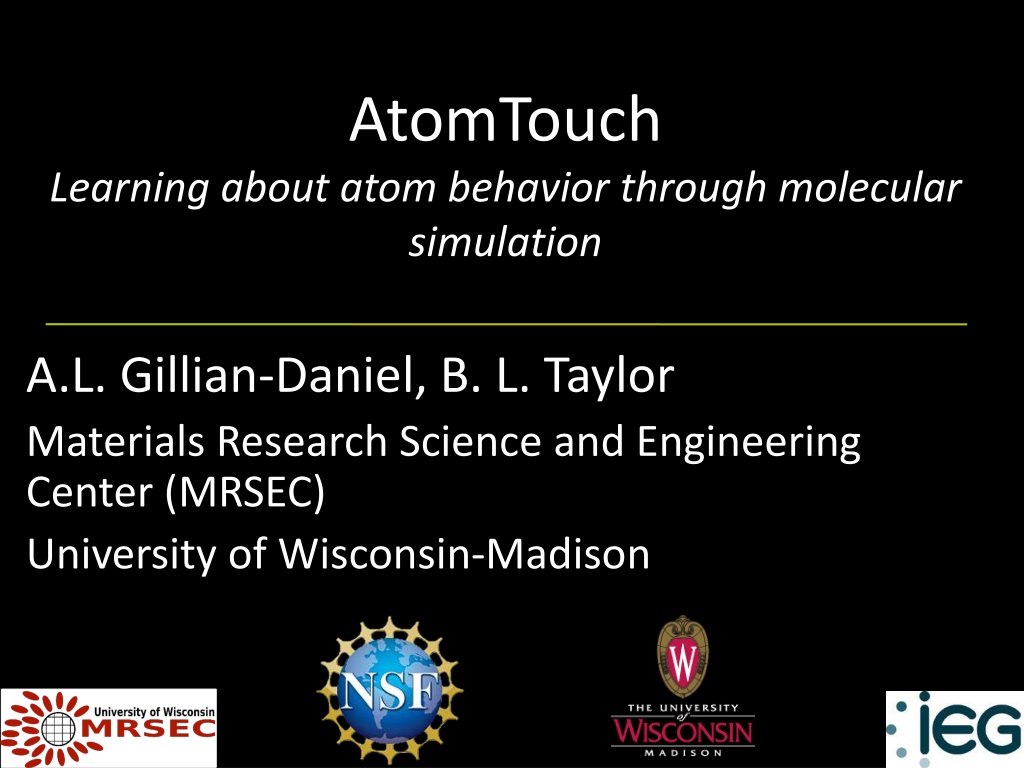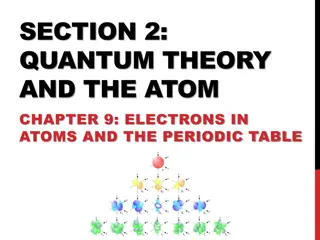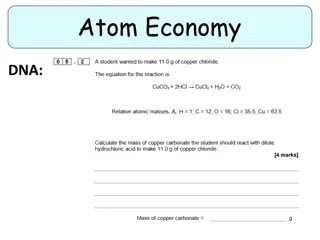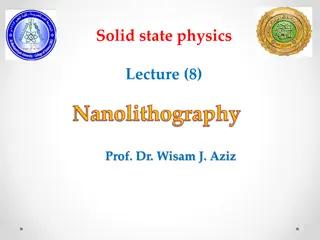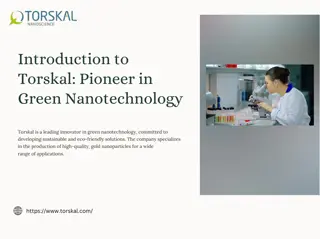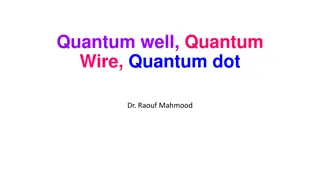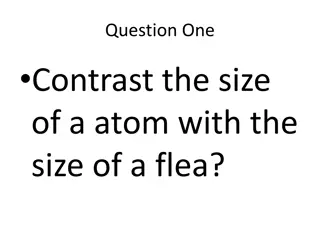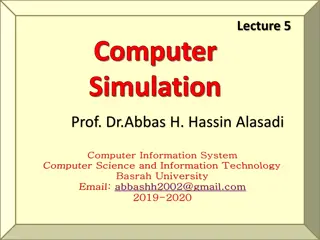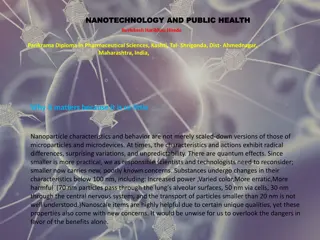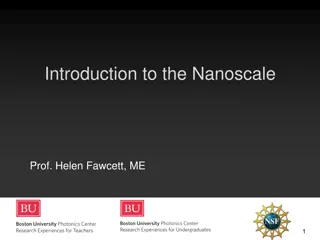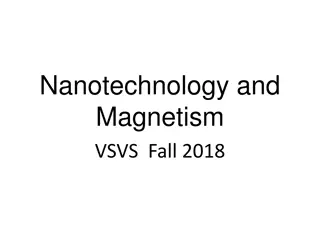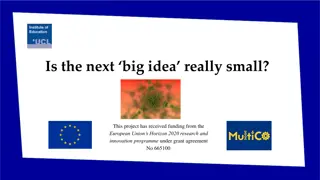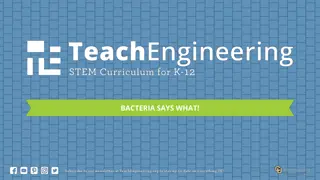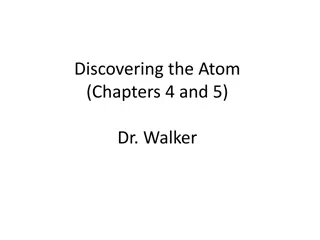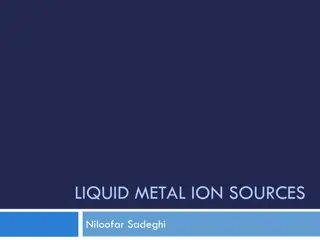Exploring Nanotechnology through Atom Behavior Simulation
Nanotechnology involves understanding and controlling matter at the nanometer scale, where materials exhibit unique behaviors. This article delves into the significance of nanometer measurements and explores how nanotechnology enables the creation of innovative materials. The content illustrates that nanoscale objects are minuscule compared to what the human eye can perceive, emphasizing the vast potential of nanotechnology in various applications.
Download Presentation

Please find below an Image/Link to download the presentation.
The content on the website is provided AS IS for your information and personal use only. It may not be sold, licensed, or shared on other websites without obtaining consent from the author. Download presentation by click this link. If you encounter any issues during the download, it is possible that the publisher has removed the file from their server.
E N D
Presentation Transcript
AtomTouch Learning about atom behavior through molecular simulation A.L. Gillian-Daniel, B. L. Taylor Materials Research Science and Engineering Center (MRSEC) University of Wisconsin-Madison
What is nanotechnology? Nanotechnology is the understanding and control of matter 1 to 100 nanometers in size. . . . But what does that mean?
What is nanotechnology? 1. The nanometer is extremelysmall. 2. At the nanometer scale, many materials behave differently. 3. We can harness this new behavior to make new materials. How small is extremely small?
Exactly how small is a nanometer? 1/100th of a meter (centimeter) meter 1/1000th of a meter (millimeter) All these are still visible with your eyes.
How small can you see? A human hair is ~40 m One red blood cell is 6-8 m A micrometer ( m) is one-millionth of a meter Nanoscale objects are 1,000 times smaller!!!
. . . Smaller than you can see! A nanometer (nm) is one billionth of a meter!! Viruses 3-50 nm DNA 1-2 nm
Nanometer: Part of the Metric System 1X103 kilometer km 1,000 WI is 420 km wide 1X100 meter m 1 11-year-old human ~ 1.4 m 1X10-3 millimeter mm 1/1,000 micrometer m 1X10-6 1/1,000,000 1X10-9 nanometer nm 1/1,000,000,000 Hair: ~40 m 1/1,000,000,000,000 1X10-12 picometer pm DNA: 1-2 nm
Nano Fun Facts In the time it takes to read this sentence, your fingernails will have grown approximately one nanometer (1 nm). If everyone on earth was 1 nm, we would all fit into a Matchbox car.
Lets explore AtomTouch Tip https://mobile.wisc.edu/mli- projects/project-atomtouch/ Atom Tunable bond Surface
AtomTouch is a molecular dynamics simulation What is a simulation? The imitation of how a real-world process or system operates over time. Simulations are used to study, understand, and predict how something works
Simulations are used to investigate things that are too expensive, difficult or dangerous to study in the real-world Nuclear Reactor Core Satellite Launches Flight Simulator http://www.space.com/23722-spacex-satellite-rocket-launch-florida-webcast.html http://dic.academic.ru/pictures/wiki/files/75/KKG_Reactor_Core.jpg http://www.riftenabled.com/admin/app/108
We use Molecular Dynamics Simulations to study materials at the nano- and atomic scales Molecular Dynamics simulations allow us to predict how atoms will interact, what materials they will form, and what properties those materials will have
What is Molecular Dynamics? A technique to move objects along the paths they should follow according to F=ma (This is called integrating the equations of motion over time) All systems evolve by F=ma (Newton s law of motion) F is specific to a specific system (ex. bat hitting a ball, gravity working on planets)
What is MD Good For? Trajectories of objects pool games and planetary orbitals Trajectories of atoms during collisions, reactions, diffusion paths Thermodynamic averages basic macroscopic properties (e.g., energy, pressure, volume)
How do you create a MD simulation Develop a potential (mathematical expression) that describes how the atoms behave and interact The potential you develop gives you F in F=ma Potentials are: Based on Coulombs law attractive forces between 2 charged particles And based on a repulsive term that keeps atoms from collapsing on each other
The Idea of Potentials Idealized potential energy curve for a typical bond, e.g., H2 Sharp repulsion due to electrons overlapping Weak long-range attraction due to Van der Waals forces r0= equilibrium bond distance Energy Separation r 0= equilibrium bonding energy Binding due to electron hybridization forming bonding orbitals We can fit the E(r) curve to a practical functional form = the Potential Once you create a potential, it may not apply in other environments (ex. other atoms) 16
Objectives and Standards Objectives: Observe atom behavior under different conditions Determine how atoms behave as materials change state Figure out the most stable structure for a molecule Science Standards:Structure and Properties of Matter MS-PS1-4. Develop a model that predicts and describes changes in particle motion, temperature, and state of a pure substance when thermal energy is added or removed. Figure out the most stable structure for a molecule HS-PS2-6. Communicate scientific and technical information about why the molecular-level structure is important in the functioning of designed materials.
Simulations are Models NGSS Crosscutting Concept- Developing and Using Models Essential Practices of Science and Engineering Develop and/or use a model to predict and/or describe phenomena. Develop a model to describe unobservable mechanisms Models bring certain features into focus while obscuring others Models are evaluated and refined - It is important for students to recognize their limitations.
Size and Scale The molecular mass of NaCl = 58.44 g/mol 1 teaspoon of NaCl weighs 5.69 g. Therefore, there are 5.86x1022 molecules of NaCl in a teaspoon of salt. http://www.wisegeek.org 1 NaCl crystal (grain of salt) weighs 0.14 mg . Therefore, there are 1.44x1018 molecules of NaCl in a grain of salt. http://waynesword.palomar.edu/lmexer1.htm
Acknowledgments MRSEC Personnel and Collaborators UW College of Engineering National Science Foundation NSF Materials Research Science and Engineering Center on Nanostructured Interfaces (DMR-1121288) NSF Research Experience for Teachers (EEC-0908782) NSF Partnership for Research and Education in Materials (DMR-0934115) RET supplement from the NSF award ECCS-1052074 to Dr. Behdad. This presentation is based upon work supported by the National Science Foundation under the following grants: DMR -1121288 (MRSEC), EEC-0908782( RET), DMR-0934115 (PREM), and NSF award ECCS- 1052074. Any opinions, findings, and conclusions or recommendations expressed in this material are those of the authors and do not necessary reflect the views of the National Science Foundation.
Thank You Anne Lynn Gillian-Daniel, agillian@wisc.edu Benjamin Taylor, bltaylor2@wisc.edu Our Website: www.education.mrsec.wisc.edu
